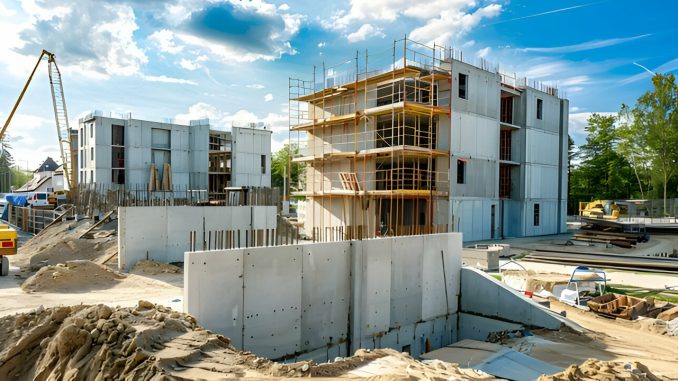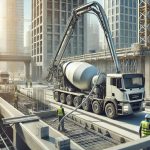
Precast concrete is changing the game in modern construction. Imagine building something as solid as a rock but faster, more efficiently, and with less waste. That’s the magic of precast concrete. Whether you’re constructing a home, a skyscraper, or a bridge, precast concrete offers unparalleled strength, durability, and flexibility.
What is Precast Concrete?
At its core, precast concrete is simply concrete that’s poured and cured in a controlled environment before being transported to a construction site. Think of it like baking a cake in a perfect oven instead of trying to bake it outdoors on a windy day. This controlled process ensures top-notch quality and consistency.
How is Precast Concrete Made?
The process involves:
- Design and Formwork: Engineers design the components, and molds are prepared.
- Pouring and Curing: Concrete is poured into molds and cured under optimal conditions.
- Transportation and Installation: Once ready, the pieces are delivered and installed on-site.
This method reduces on-site labor and speeds up construction.
Key Advantages of Precast Concrete
1. Strength and Durability
Precast concrete is built to last. It can withstand extreme weather, heavy loads, and even seismic activity.
2. Time-Saving
Precast components are ready to use, reducing construction timelines significantly.
3. Eco-Friendly
Its efficient production reduces waste, and its durability means fewer replacements, making it a sustainable choice.
Applications in Modern Construction
Precast concrete is a jack-of-all-trades in construction. Some common uses include:
- Bridges: Strong, durable, and quick to assemble.
- Buildings: From walls to floors, precast components are everywhere.
- Infrastructure: Pipes, culverts, and utility vaults are often made with precast concrete.
Precast vs. Traditional Concrete
Ever wonder how precast stacks up against traditional concrete? Here’s the breakdown:
- Precast: Manufactured in a factory, ensuring consistency and quality.
- Traditional: Poured on-site, leaving room for environmental variables to affect quality.
The winner? Precast, for its reliability and efficiency.
Sustainability and Precast Concrete
In today’s eco-conscious world, precast concrete shines as a sustainable choice. It reduces waste, uses recycled materials, and contributes to energy-efficient buildings. It’s like the green superhero of construction.
Durability and Longevity
When you build with precast concrete, you’re building for generations. Its resistance to wear and tear makes it ideal for long-term projects. Imagine a bridge standing strong for over 50 years—that’s the power of precast.
Cost-Effectiveness
While the initial costs of precast concrete might be slightly higher, the long-term savings are undeniable. With lower maintenance costs, faster construction, and fewer repairs, it pays for itself over time.
Customization Options
One of the coolest things about precast concrete is its flexibility in design. Need intricate patterns or specific shapes? Precast can do it. It’s like working with clay but with the strength of stone.
Challenges and Limitations
Precast isn’t without its challenges. Transporting large pieces can be tricky, and initial costs might deter some. However, these challenges are often outweighed by its many benefits.
Innovations in Precast Technology
The precast industry isn’t standing still. Innovations like 3D printing, self-healing concrete, and advanced curing techniques are pushing the boundaries of what’s possible.
Case Studies: Precast in Action
1. The Brooklyn Bridge Upgrade
Precast components helped refurbish this iconic bridge faster and more efficiently.
2. Sustainable Housing in Sweden
Entire neighborhoods were built using eco-friendly precast concrete solutions.
Why Choose Precast Concrete for Your Project?
Choosing precast concrete is like choosing reliability, durability, and efficiency wrapped in one package. It’s the smart choice for anyone looking to save time, money, and resources.
Precast Concrete and Safety
Safety is a cornerstone of any construction project, and precast concrete delivers on this front. Its factory-controlled production ensures consistent quality, reducing the risks of structural weaknesses. Additionally, precast components are designed to withstand fire, earthquakes, and severe weather conditions, offering enhanced protection for buildings and infrastructure. For construction crews, using precast reduces on-site hazards since much of the work happens offsite in a controlled environment. It’s like having an added layer of assurance for both workers and future occupants.
Speeding Up Urban Development
In rapidly growing urban areas, time is of the essence. Precast concrete plays a crucial role in meeting tight deadlines while maintaining quality. Cities worldwide are leveraging precast elements to construct housing complexes, commercial spaces, and essential infrastructure more efficiently. Imagine an entire apartment block assembled in weeks instead of months—this is the power of precast in action. With urban populations rising, precast offers a solution to build smarter and faster without compromising durability or design.
Enhancing Aesthetic Appeal
Beyond its strength and functionality, precast concrete also brings beauty to the table. Architects and designers appreciate its versatility, allowing them to create visually stunning structures. From intricate patterns on building facades to smooth, polished finishes in interiors, precast concrete can be as much about aesthetics as it is about practicality. It’s like sculpting art out of a material that also happens to be incredibly robust. Whether you’re aiming for sleek modernity or timeless elegance, precast concrete is up to the task.
Future of Precast Concrete
The future looks bright, with advancements in technology making precast concrete more accessible, sustainable, and versatile. As construction evolves, precast will undoubtedly remain at the forefront.
Key Takeaways:
- Precast concrete offers unmatched strength, durability, and efficiency in construction.
- It’s time-saving, with faster installation and reduced on-site labor.
- Sustainability is a core advantage, aligning with eco-friendly goals.
- Innovations in technology continue to enhance its potential.
- Precast is a versatile choice, suitable for everything from homes to highways.
With its countless advantages and evolving capabilities, precast concrete is shaping the future of construction, one solid piece at a time. Whether you’re a builder, an architect, or just curious, understanding precast concrete is key to appreciating modern construction marvels.
What makes precast concrete different from regular concrete?
Precast concrete is made in a controlled environment, ensuring higher quality and faster installation compared to regular on-site concrete.
Can precast concrete be customized?
Absolutely! Precast concrete can be molded into various shapes and designs to fit specific project needs.
Is precast concrete environmentally friendly?
Yes, it’s a sustainable choice with less waste, longer durability, and options for using recycled materials.





